Page 379 of 493
WHAT TO DO IN EMERGENCIES
CONTENTS
�Hazard Warning Flasher................ 378
�If Your Engine Overheats................ 379
�TIREFIT Kit......................... 380
�Jump-Starting Procedures................ 385
�Freeing A Stuck Vehicle................. 389
�Towing A Disabled Vehicle............... 390▫Without The Ignition Key.............. 390
▫Towing This Vehicle Behind Another Vehicle
(Flat Towing With All Four Wheels On The
Ground)........................... 390
▫Towing This Vehicle Behind Another Vehicle
With A Tow Dolly.................... 391
6
Page 383 of 493
1. Air pump hose
2. Power plug and cable
3. AIR PUMP switch
4. Pressure gauge5. TIREFIT sealant bottle
6. TIREFIT sealant hose
WARNING!
•Do not attempt to repair a tire on the side of the
vehicle close to traffic. Pull far enough off the road
to avoid the danger of being hit when operating
the jack or repairing a tire.
•Cuts or punctures larger than approximately
0.16 in (4 mm), tire damage caused by driving with
extremely low tire pressure or on a flat tire, or a
damaged wheel can pose a hazard while driving.
TIREFIT should not be used in such circum-
stances. Do not drive the vehicle under such cir-
cumstances. Contact your nearest authorized
dealer for assistance.
(Continued)
Tirefit Kit
WHAT TO DO IN EMERGENCIES 381
6
Page 384 of 493
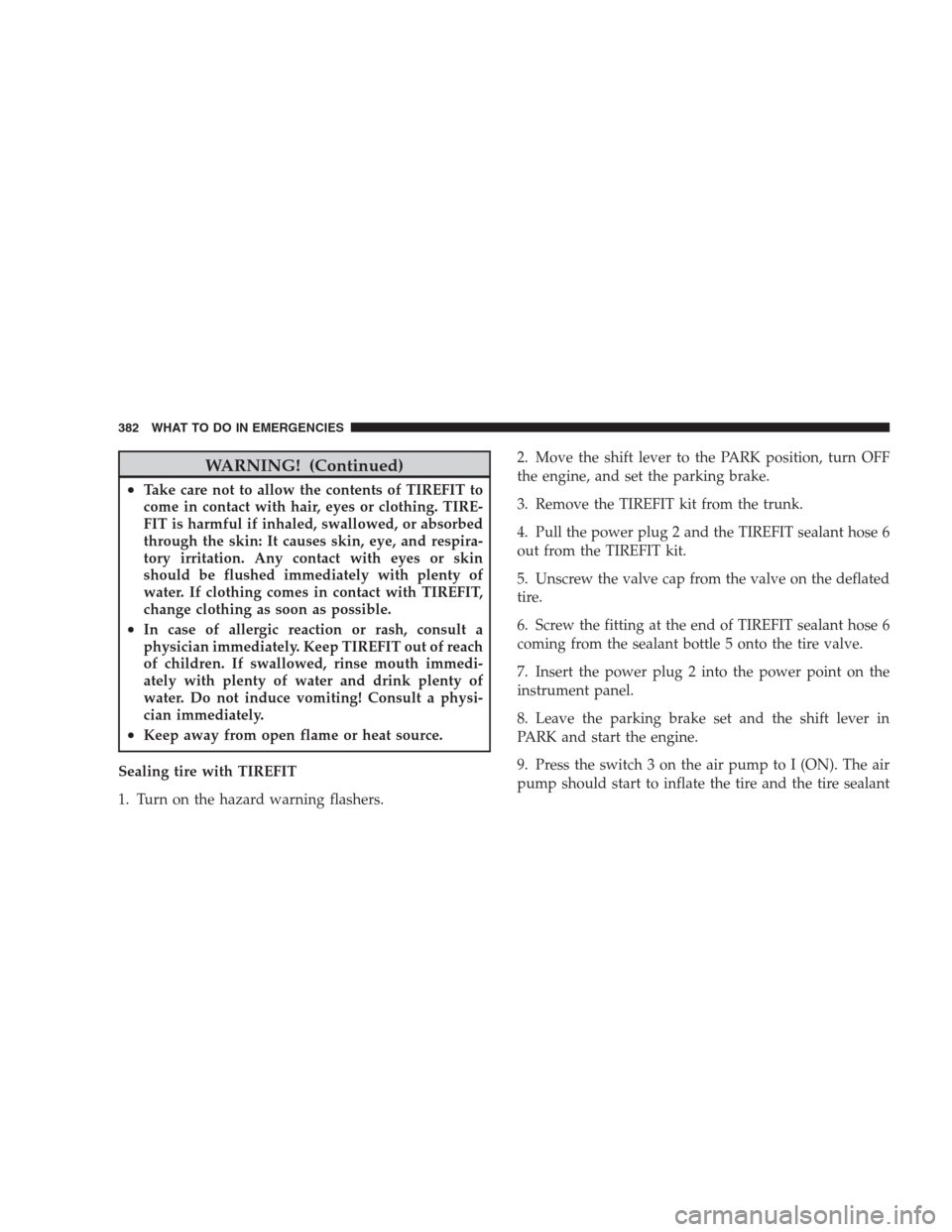
WARNING! (Continued)
•Take care not to allow the contents of TIREFIT to
come in contact with hair, eyes or clothing. TIRE-
FIT is harmful if inhaled, swallowed, or absorbed
through the skin: It causes skin, eye, and respira-
tory irritation. Any contact with eyes or skin
should be flushed immediately with plenty of
water. If clothing comes in contact with TIREFIT,
change clothing as soon as possible.
•In case of allergic reaction or rash, consult a
physician immediately. Keep TIREFIT out of reach
of children. If swallowed, rinse mouth immedi-
ately with plenty of water and drink plenty of
water. Do not induce vomiting! Consult a physi-
cian immediately.
•Keep away from open flame or heat source.
Sealing tire with TIREFIT
1. Turn on the hazard warning flashers.2. Move the shift lever to the PARK position, turn OFF
the engine, and set the parking brake.
3. Remove the TIREFIT kit from the trunk.
4. Pull the power plug 2 and the TIREFIT sealant hose 6
out from the TIREFIT kit.
5. Unscrew the valve cap from the valve on the deflated
tire.
6. Screw the fitting at the end of TIREFIT sealant hose 6
coming from the sealant bottle 5 onto the tire valve.
7. Insert the power plug 2 into the power point on the
instrument panel.
8. Leave the parking brake set and the shift lever in
PARK and start the engine.
9. Press the switch 3 on the air pump to I (ON). The air
pump should start to inflate the tire and the tire sealant
382 WHAT TO DO IN EMERGENCIES
Page 385 of 493
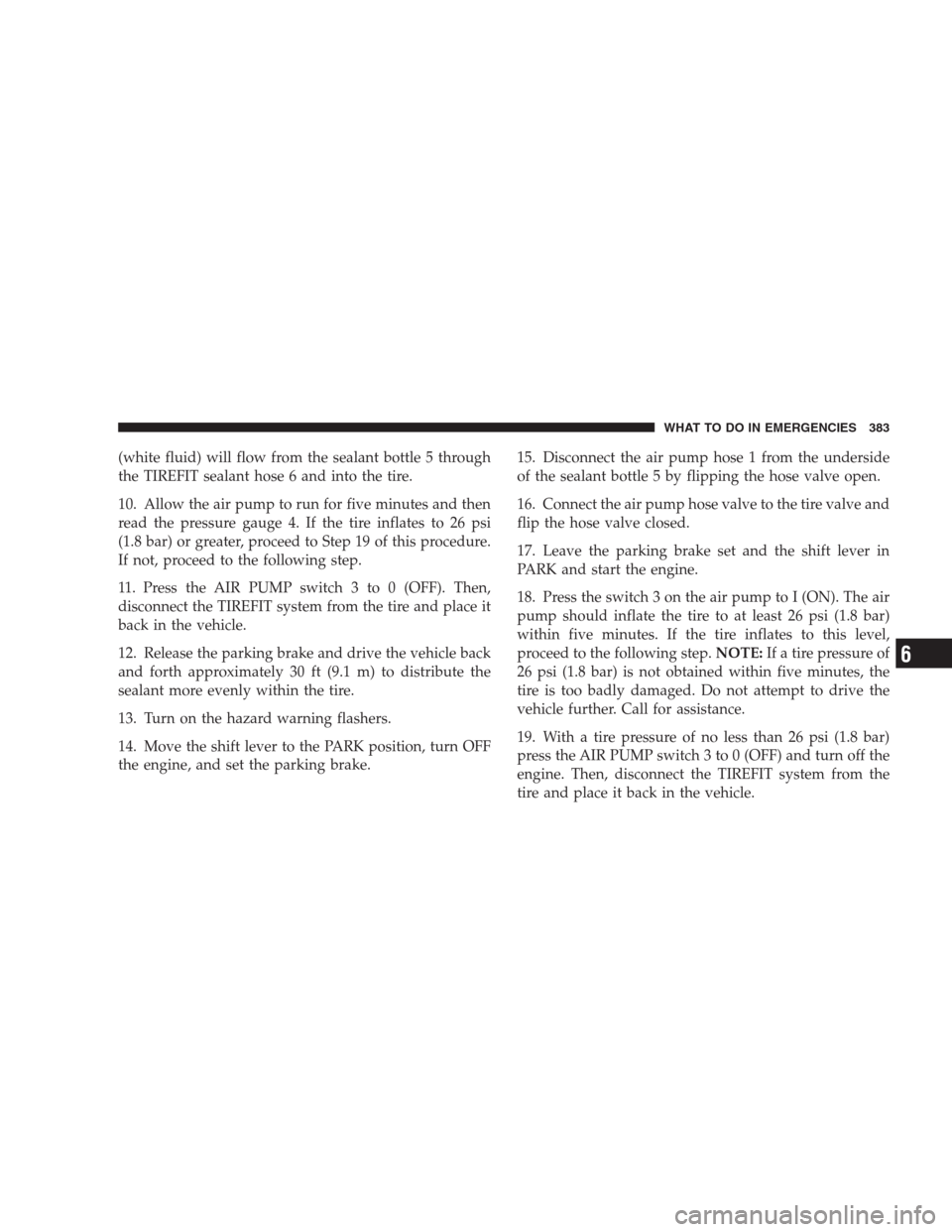
(white fluid) will flow from the sealant bottle 5 through
the TIREFIT sealant hose 6 and into the tire.
10. Allow the air pump to run for five minutes and then
read the pressure gauge 4. If the tire inflates to 26 psi
(1.8 bar) or greater, proceed to Step 19 of this procedure.
If not, proceed to the following step.
11. Press the AIR PUMP switch 3 to 0 (OFF). Then,
disconnect the TIREFIT system from the tire and place it
back in the vehicle.
12. Release the parking brake and drive the vehicle back
and forth approximately 30 ft (9.1 m) to distribute the
sealant more evenly within the tire.
13. Turn on the hazard warning flashers.
14. Move the shift lever to the PARK position, turn OFF
the engine, and set the parking brake.15. Disconnect the air pump hose 1 from the underside
of the sealant bottle 5 by flipping the hose valve open.
16. Connect the air pump hose valve to the tire valve and
flip the hose valve closed.
17. Leave the parking brake set and the shift lever in
PARK and start the engine.
18. Press the switch 3 on the air pump to I (ON). The air
pump should inflate the tire to at least 26 psi (1.8 bar)
within five minutes. If the tire inflates to this level,
proceed to the following step.NOTE:If a tire pressure of
26 psi (1.8 bar) is not obtained within five minutes, the
tire is too badly damaged. Do not attempt to drive the
vehicle further. Call for assistance.
19. With a tire pressure of no less than 26 psi (1.8 bar)
press the AIR PUMP switch 3 to 0 (OFF) and turn off the
engine. Then, disconnect the TIREFIT system from the
tire and place it back in the vehicle.
WHAT TO DO IN EMERGENCIES 383
6
Page 386 of 493
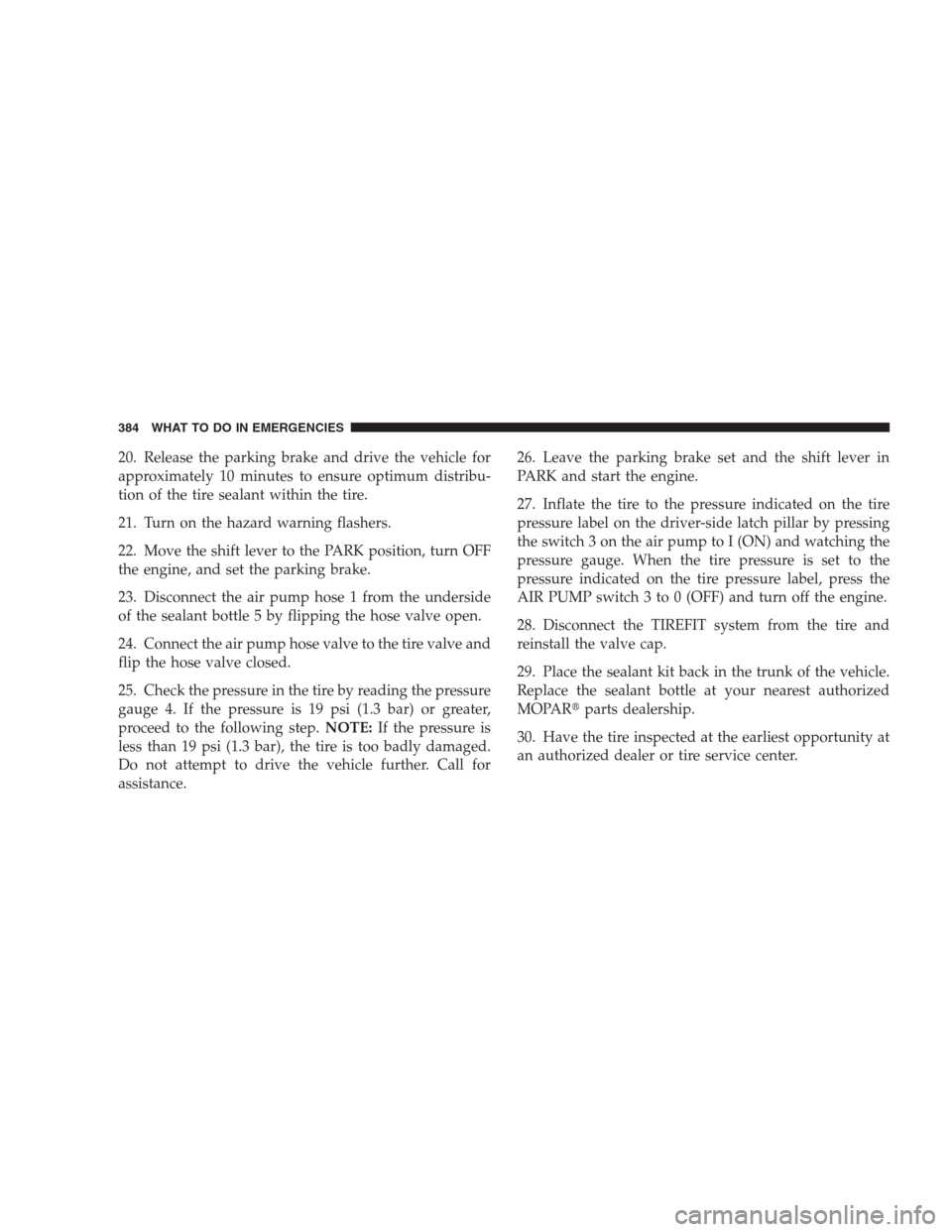
20. Release the parking brake and drive the vehicle for
approximately 10 minutes to ensure optimum distribu-
tion of the tire sealant within the tire.
21. Turn on the hazard warning flashers.
22. Move the shift lever to the PARK position, turn OFF
the engine, and set the parking brake.
23. Disconnect the air pump hose 1 from the underside
of the sealant bottle 5 by flipping the hose valve open.
24. Connect the air pump hose valve to the tire valve and
flip the hose valve closed.
25. Check the pressure in the tire by reading the pressure
gauge 4. If the pressure is 19 psi (1.3 bar) or greater,
proceed to the following step.NOTE:If the pressure is
less than 19 psi (1.3 bar), the tire is too badly damaged.
Do not attempt to drive the vehicle further. Call for
assistance.26. Leave the parking brake set and the shift lever in
PARK and start the engine.
27. Inflate the tire to the pressure indicated on the tire
pressure label on the driver-side latch pillar by pressing
the switch 3 on the air pump to I (ON) and watching the
pressure gauge. When the tire pressure is set to the
pressure indicated on the tire pressure label, press the
AIR PUMP switch 3 to 0 (OFF) and turn off the engine.
28. Disconnect the TIREFIT system from the tire and
reinstall the valve cap.
29. Place the sealant kit back in the trunk of the vehicle.
Replace the sealant bottle at your nearest authorized
MOPAR�parts dealership.
30. Have the tire inspected at the earliest opportunity at
an authorized dealer or tire service center.
384 WHAT TO DO IN EMERGENCIES
Page 392 of 493
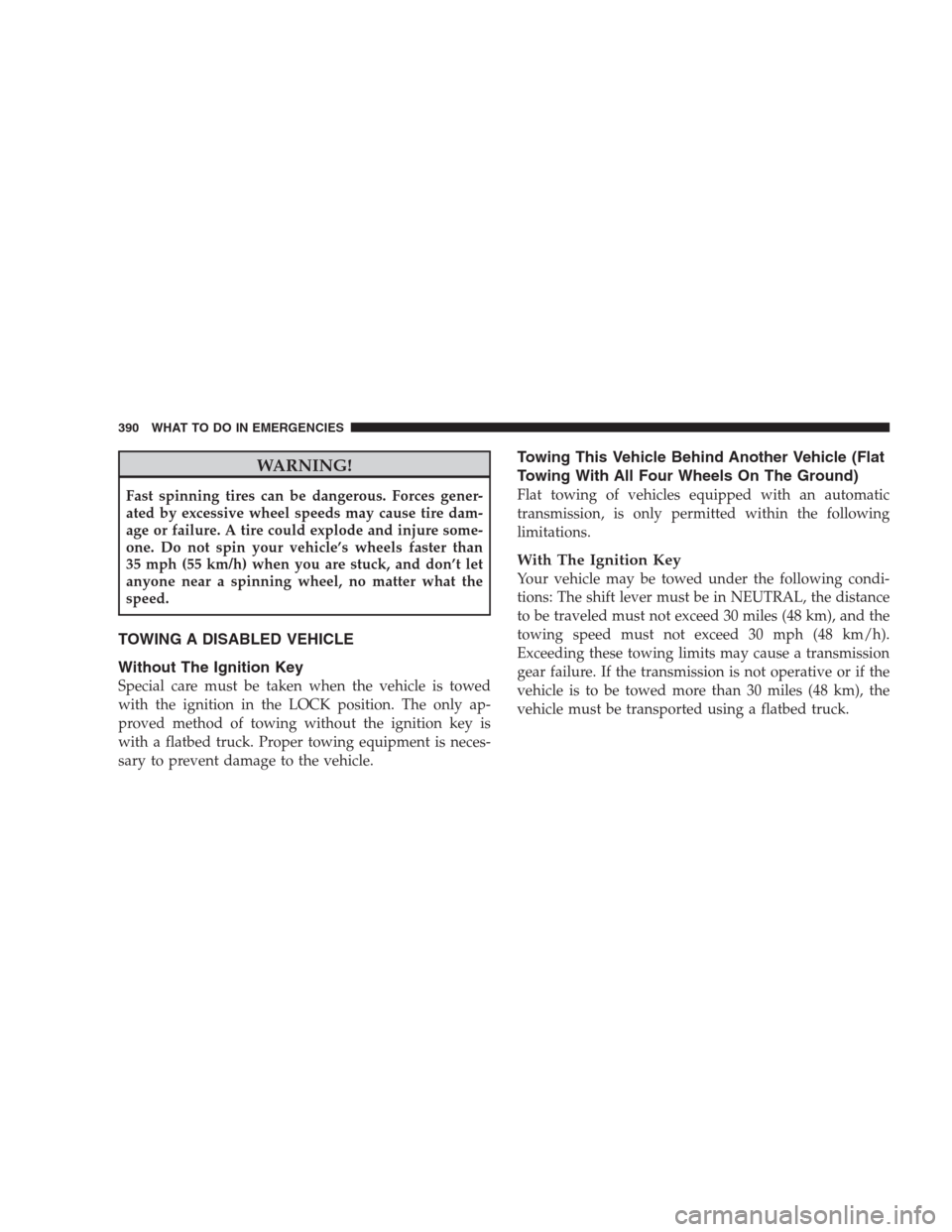
WARNING!
Fast spinning tires can be dangerous. Forces gener-
ated by excessive wheel speeds may cause tire dam-
age or failure. A tire could explode and injure some-
one. Do not spin your vehicle’s wheels faster than
35 mph (55 km/h) when you are stuck, and don’t let
anyone near a spinning wheel, no matter what the
speed.
TOWING A DISABLED VEHICLE
Without The Ignition Key
Special care must be taken when the vehicle is towed
with the ignition in the LOCK position. The only ap-
proved method of towing without the ignition key is
with a flatbed truck. Proper towing equipment is neces-
sary to prevent damage to the vehicle.
Towing This Vehicle Behind Another Vehicle (Flat
Towing With All Four Wheels On The Ground)
Flat towing of vehicles equipped with an automatic
transmission, is only permitted within the following
limitations.
With The Ignition Key
Your vehicle may be towed under the following condi-
tions: The shift lever must be in NEUTRAL, the distance
to be traveled must not exceed 30 miles (48 km), and the
towing speed must not exceed 30 mph (48 km/h).
Exceeding these towing limits may cause a transmission
gear failure. If the transmission is not operative or if the
vehicle is to be towed more than 30 miles (48 km), the
vehicle must be transported using a flatbed truck.
390 WHAT TO DO IN EMERGENCIES
Page 470 of 493
Temperature Grades
The temperature grades are A (the highest), B, and C,
representing the tire’s resistance to the generation of heat
and its ability to dissipate heat, when tested under
controlled conditions on a specified indoor laboratory
test wheel. Sustained high temperature can cause the
material of the tire to degenerate and reduce tire life, and
excessive temperature can lead to sudden tire failure. The
grade C corresponds to a level of performance, which all
passenger car tires must meet under the Federal Motor
Vehicle Safety Standard No. 109. Grades B and A repre-
sent higher levels of performance on the laboratory test
wheel, than the minimum required by law.WARNING!
The temperature grade for this tire is established for
a tire that is properly inflated and not overloaded.
Excessive speed, under-inflation, or excessive load-
ing, either separately or in combination, can cause
heat buildup and possible tire failure.
468 IF YOU NEED CONSUMER ASSISTANCE
Page 489 of 493
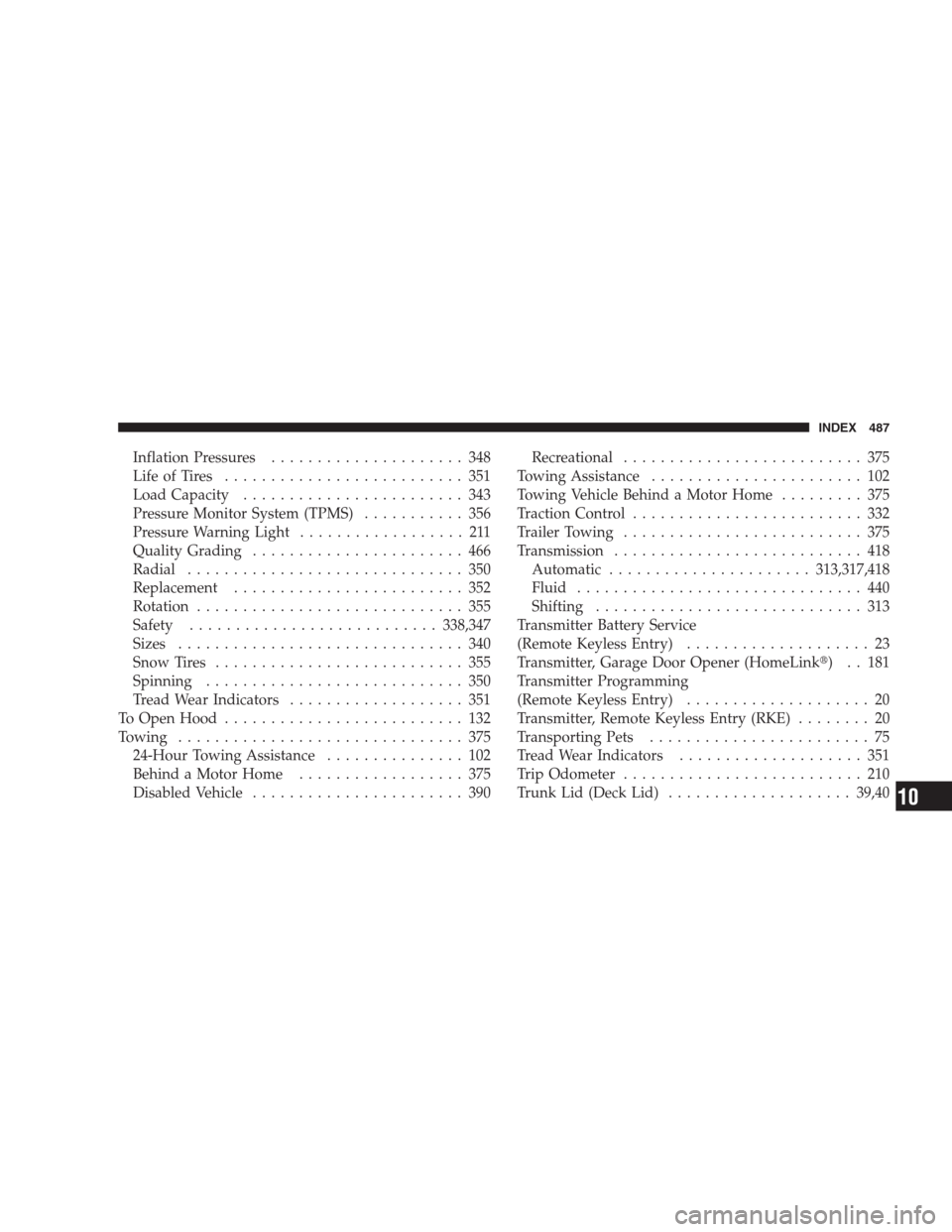
Inflation Pressures..................... 348
Life of Tires.......................... 351
Load Capacity........................ 343
Pressure Monitor System (TPMS)........... 356
Pressure Warning Light.................. 211
Quality Grading....................... 466
Radial.............................. 350
Replacement......................... 352
Rotation............................. 355
Safety...........................338,347
Sizes............................... 340
Snow Tires........................... 355
Spinning............................ 350
Tread Wear Indicators................... 351
To Open Hood.......................... 132
Towing............................... 375
24-Hour Towing Assistance............... 102
Behind a Motor Home.................. 375
Disabled Vehicle....................... 390Recreational.......................... 375
Towing Assistance....................... 102
Towing Vehicle Behind a Motor Home......... 375
Traction Control......................... 332
Trailer Towing.......................... 375
Transmission........................... 418
Automatic......................313,317,418
Fluid............................... 440
Shifting............................. 313
Transmitter Battery Service
(Remote Keyless Entry).................... 23
Transmitter, Garage Door Opener (HomeLink�) . . 181
Transmitter Programming
(Remote Keyless Entry).................... 20
Transmitter, Remote Keyless Entry (RKE)........ 20
Transporting Pets........................ 75
Tread Wear Indicators.................... 351
Trip Odometer.......................... 210
Trunk Lid (Deck Lid)....................39,40
INDEX 487
10
Page:
< prev 1-8 9-16 17-24